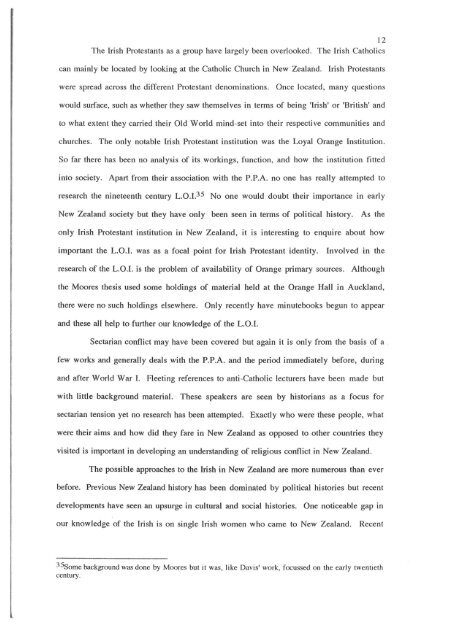TRANSPLANTED IRISH INSTITUTIONS - University of Canterbury
TRANSPLANTED IRISH INSTITUTIONS - University of Canterbury
TRANSPLANTED IRISH INSTITUTIONS - University of Canterbury
You also want an ePaper? Increase the reach of your titles
YUMPU automatically turns print PDFs into web optimized ePapers that Google loves.
12<br />
The Irish Protestants as a group have largely been overlooked. The Irish Catholics<br />
can mainly be located by looking at the Catholic Church in New Zealand. Irish Protestants<br />
were spread across the different Protestant denominations. Once located, many questions<br />
would surface, such as whether they saw themselves in terms <strong>of</strong> being 'Irish' or 'British' and<br />
to what extent they carried their Old World mind-set into their respective communities and<br />
churches. The only notable Irish Protestant institution was the Loyal Orange Institution.<br />
So far there has been no analysis <strong>of</strong> its workings, function, and how the institution fitted<br />
into society. Apart from their association with the P.P.A. no one has really attempted to<br />
research the nineteenth century L.O.1. 35 No one would doubt their importance in early<br />
New Zealand society but they have only been seen in terms <strong>of</strong> political history.<br />
As the<br />
only Irish Protestant institution in New Zealand, it is interesting to enquire about how<br />
important the L.O.1. was as a focal point for Irish Protestant identity.<br />
Involved in the<br />
research <strong>of</strong> the L.O.1. is the problem <strong>of</strong> availability <strong>of</strong> Orange primary sources. Although<br />
the Moores thesis used some holdings <strong>of</strong> material held at the Orange Hall in Auckland,<br />
there were no such holdings elsewhere. Only recently have minutebooks begun to appear<br />
and these all help to further our knowledge <strong>of</strong> the L.O.I.<br />
Sectarian conflict may have been covered but again it is only from the basis <strong>of</strong> a .<br />
few works and generally deals with the P.P.A. and the period immediately before, during<br />
and after World War I.<br />
Reeting references to anti-Catholic lecturers have been made but<br />
with little background material. These speakers are seen by historians as a focus for<br />
sectarian tension yet no research has been attempted. Exactly who were these people, what<br />
were their aims and how did they fare in New Zealand as opposed to other countries they<br />
visited is important in developing an understanding <strong>of</strong> religious conflict in New Zealand.<br />
The possible approaches to the Irish in New Zealand are more numerous than ever<br />
before. Previous New Zealand history has been dominated by political histories but recent<br />
developments have seen an upsurge in cultural and social histories. One noticeable gap in<br />
our knowledge <strong>of</strong> the Irish is on single Irish women who came to New Zealand.<br />
Recent<br />
35some background was done by Moores but it was, like Davis' work, focussed on the early twentieth<br />
century.
















